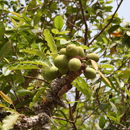Brief Summary
(
İngilizce
)
EOL authors tarafından sağlandı
Vitellaria paradoxa, shea, shea butter, or shea-buttertree (also called karite-nut), is a large, long-lived tree in the Sapotaceae (soapberry family) that is native to the Sahel region of West Africa and is a key species in traditional agroforestry systems (vital for erosion control) and an important source of edible oil, shea butter, which is derived from the seed. Shea butter is also used in cosmetics, skin emollients, and pharmaceuticals, and has become increasingly popular outside Africa for these uses in the past three decades, increasing its value as a cash crop (it was Ghana’s 3rd-ranked cash crop in 2006). Shea can also be used for its edible flowers and fruit, in traditional medicine (to treat wounds and sprains, as a decongestant, and as an arthritis treatment). Its wood, which is hard and reportedly termite-resistant, is desirable as lumber, and was traditionally used to make coffins for kings. The wood is also good for making charcoal. Shea trees are protected from harvest in many places by local and state regulations, but are still classified as vulnerable on the IUCN red list, due to threats from timber and fuel harvest, as well as increasing agricultural encroachment. The shea tree, which resembles an oak (Quercus species) in its general size and form, grows up to 20 m (65 ft) tall and 1 m (3 ft) in diameter, with a dense, many-branched crown. It is deciduous, but appears evergreen, because new leaves emerge as the old ones fall. The bark is thick, deeply fissured, and fire-resistant. The tough, leathery leaves are elliptical to oblong, with entire margins, and are clustered at the branch tips (alternate to whorled). The flowers are cream to brown, in dense terminal clusters, and are insect-pollinated. The fruits are round to elliptical drupes, 3 to 6 cm (1.1 to 2.25 in long), borne on peduncles (fruit stalks) 1 to 3 cm (0.5 to 1.25 in) long. The fruits are drupes, with fleshy greenish yellow pulp surround a hard- but thin-shelled seed, an egg-shaped kernel that weighs around 3 gm (about 1/10 of an ounce). The process of purifying shea butter from the seeds is labor-intensive, but results in an oil that is solid at room temperatures, forming a white creamy to solid paste, which is used in foods and for frying. Shea trees are difficult to propagate, and only in recent years have plantations begun to be established. However, as the focus of a long-established traditional agroforestry system, millions of trees have been nurtured on thousands of hectares of land in the Sahel, over hundreds, if not thousands, of years. (IUCN 2012, National Research Council 2006, Wiersema and León 1999.)

